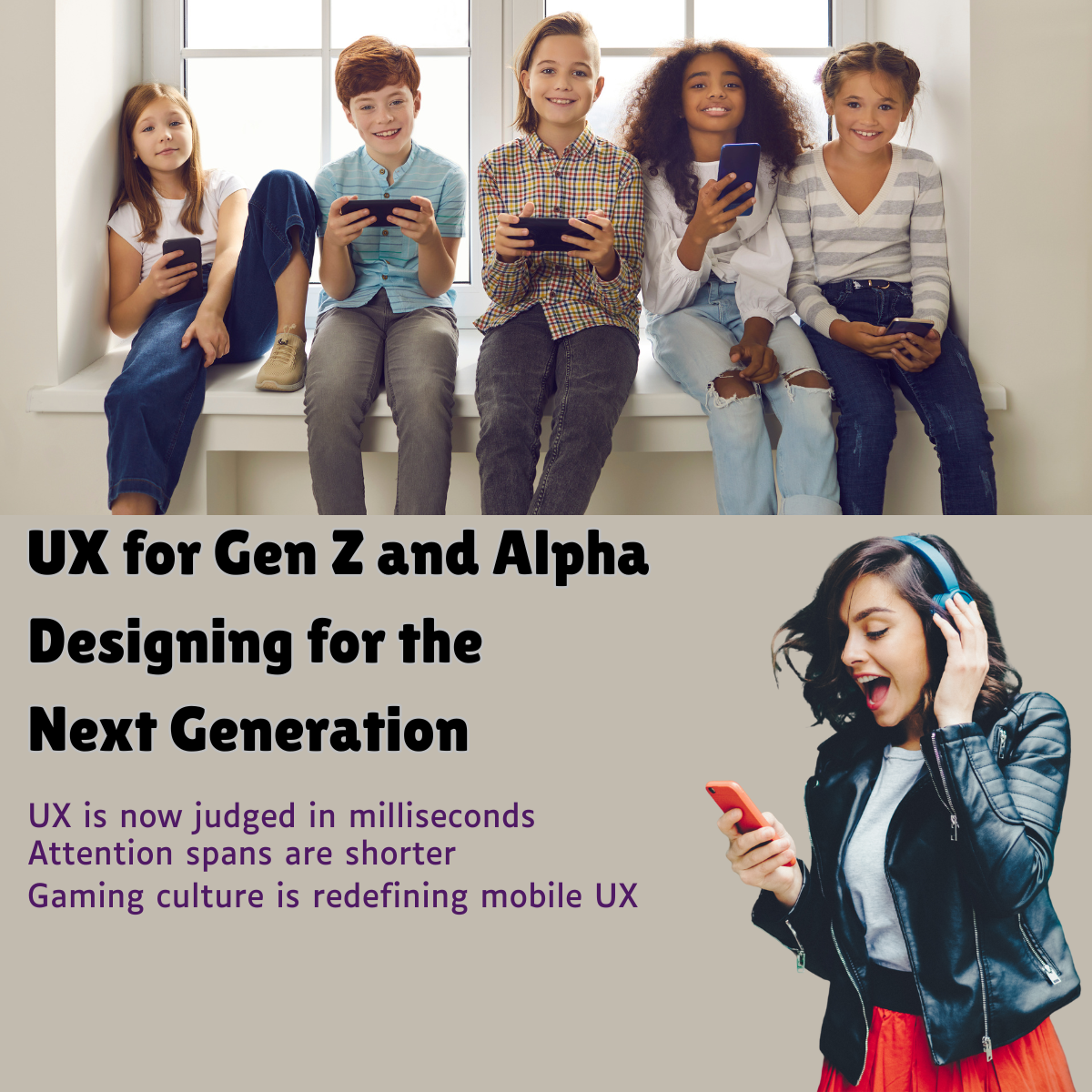Posted At: Aug 06, 2025 - 320 Views

🎯 UX for Gen Z and Alpha: What Younger Users Expect in 2025
The digital natives are not coming, they’re already here. Gen Z (born 1997–2012)and Gen Alpha (born 2013 onward)are redefining how we design, interact, and experience digital products. If you're building apps, websites, or platforms in 2025, your success depends on understanding what these users expect—and demand—from UX.
These are users who grew up swiping before they could write, talking to voice assistants before typing on a keyboard, and consuming content at lightning speed across multiple devices.
So, what does great UXlook like to Gen Z and Alpha in 2025? Let’s dive in.
🧠 1. Instant, Intuitive, and Invisible UX
For younger users, patience is not a virtue—it’s a barrier. Interfaces must feel natural, fast, and frictionless.
- Loading screens are UX failures.Lag kills interest instantly. Optimize for speed.
- No manuals, no tutorials.If users have to ask "how does this work?", you've already lost them.
- Navigation should feel like instinct, not instruction.Think thumb-first, swipe-friendly design.
Tip:Prioritize micro-interactions, seamless onboarding, and real-time feedback to reduce cognitive load.
🎨 2. Bold, Dynamic Visual Language
Gen Z and Alpha are visually driven. They grew up on TikTok, Instagram Reels, Roblox, and Fortnite—not Facebook or Excel.
- Designs must be visually expressive—dynamic colors, motion, and immersive transitions win attention.
- Dark mode is not a feature—it’s a default.
- Typography matters.Use bold fonts, custom iconography, and emoji support where appropriate.
Tip:Keep interfaces flexible and aesthetic but avoid overwhelming them with clutter. Clarity still wins.
🔁 3. Personalization as a Standard
Young users expect products to adapt to them, not the other way around.
- Interfaces should be customizable—from themes to dashboards to notification settings.
- Use behavioral datato personalize content, product suggestions, and experiences.
- Avatars, profiles, and self-expressiontools are essential, especially in apps for Gen Alpha.
Tip:Build AI-powered UX that learns and evolves with the user—but stay transparent about how data is used.
💬 4. Conversational & Social by Default
Forget static forms and menus Gen Z and Alpha interact through conversations.
- Integrate chatbots, AI assistants, and even voice UXwhere appropriate.
- Support in-app community features, reactions, and social sharing tools.
- Collaborative UX—like co-editing, live sessions, and group actions—is highly engaging.
Tip:Design for community-building, even in utility apps. Social interaction is core UX, not an add-on.
🕹 5. Gamification and Playful UX
Gamified elements make your product sticky. It’s not just for games—every app is judged on how fun and engaging it feels.
- Use badges, streaks, leaderboards, and achievementsto motivate users.
- Add animated progress indicators, rewards, and easter eggs.
- Integrate touch gestures, AR features, or haptic feedback to create interactive delight.
Tip:Even serious apps (like finance or education) can use playful design without losing professionalism.
🛡 6. Privacy and Control Matter
Don’t mistake their love for sharing with a lack of concern for privacy. Gen Z is more data-conscious than millennials.
- Make privacy settings clear, simple, and front-facing.
- Provide easy opt-outsand consent-driven features.
- Be transparentabout how data is collected and used.
Tip:Trust is part of the UX. Ethical design earns loyalty in a skeptical, digital-first generation.
🔗 7. Cross-Platform and Device-Agnostic
Young users move across screensfluidly, phones, tablets, smart TVs, watches, and even VR headsets.
- UX must be responsive, not just in layout but in functionality and continuity.
- Save states, synced progress, and seamless handoffs are expected features, not premium perks.
Tip:Design for experiences, not devices. Think cross-channel consistency over channel-specific perfection.
🔮 8. Emerging UX Expectations in 2025
The line between digital and physical is blurring fast. These users are growing up in a phygitalworld.
- AR-ready interfacesfor shopping, education, and entertainment
- Voice-first UXfor smart home ecosystems
- 3D spatial navigationin apps and environments
- AI co-creation toolsfor music, design, and content creation
Tip:Stay ahead by integrating features that feel futuristic—but functionally useful.
✅ Key Takeaways
To build UX for Gen Z and Alpha in 2025:
- Design for speed, self-expression, and simplicity
- Think visually, socially, and conversationally
- Offer customization and control
- Respect privacy and build trust
- Stay adaptive across devices and formats
These generations don’t just use digital products—they live in them. Your UX needs to feel less like software and more like a natural extension of their world
